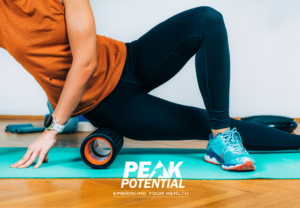
Shin splints, also known as tibial stress syndrome, are a common name for pain that affects the lower leg when it’s been subjected to too much pressure. We most often see this in runners and people new to a walking program. Whatever the cause, many cases respond well to at home treatments or heal quickly with minimal intervention.
Even better, you can usually prevent shin splints by adjusting your workout routine. However, completely ignoring the problem – or just hoping the discomfort will go away on it’s own – isn’t likely to work in this case.
So, it’s best to figure out what’s going on and do something to move your body toward recovery. If you didn’t catch our conversation about what shin splints are and how to prevent them, check out lasts weeks blog post . . . What Are Shin Splints and How to Prevent Them.
When persistent pain is getting in the way of your training, or walking, or just life, it’s time to be intentional about recovery.
Here are 6 Ways You Can Help Your Body Heal:
-
Take the Pressure Off
Stop what you’re doing at the first sign of pain. Try to “stretch it out” and if the pain persists give yourself a break. You don’t have to stop training all together but don’t continue activities by pushing past pain. DIY shin splint recovery can take 3-6 months to heal and be completely pain free – a reason why you may want to skip ahead to tip #6.
-
Lower the Impact
If you decide to take some time off from the activity that causes you pain, you can still stay fit with lower impact activities. Try swimming, biking, or yoga to workout safely. You can also lower the impact on your body by performing activities on a more cushioned surface such as grass or carpet – as opposed to asphalt or concrete.
-
Elevate the Legs
Reduce swelling by using a pillow to raise your shin above heart level. This works well when you do it overnight. Along with elevation, ice may help ease or numb pain symptoms.
-
Work on Inflammation
People often take anti-inflammatory medications to reduce the pain of shin splints. This may be necessary, but due to side effects should really be a last resort. Try other anti-inflammatory strategies such as taking a fish oil supplement and increasing antioxidant rich foods such as dark leafy greens and berries.
-
Stretch & Strengthen
If you read last weeks blog post (link HERE), you know that shin splits are primarily an issue of muscle imbalance. This means that some muscles are too tight while the muscles that are supposed to help them are too weak. Stretching those tight muscles while strengthening the weak ones will correct this muscle imbalance. Not sure what to stretch or strength? Then go head on to tip 6.
-
Consult Your Physical Therapist
A physical therapist specializing in orthopedics can help you find the root cause of the problem, get you pain relief, and move along the healing process more efficiently. A treatment plan may include stretches targeting the affected muscles in the leg, calf, and foot, therapeutic massage, taping the foot to reduce load, and suggestions on proper exercise form.
We have to add that resting, icing, or stretching alone will not heal your shin splints – neither will just addressing the sore spot on the front of your shin. Your entire body works together and everything from your feet, up your leg, and into your hip and back must be working properly to keep from “over stressing” the lower leg.
If you try some of the above tips and continue to have pain for more than a few days, give us a call and let us help you sort it out. Our specialist physical therapists can guide you toward your next best step whether that is a different at home treatment, seeking a physician referral to rule out a stress fracture, or considering physical therapy to address your unique needs.
Our goal is always to get you back to what you love faster!
Click the link below to start a conversation with a doctor of physical therapy today ????




